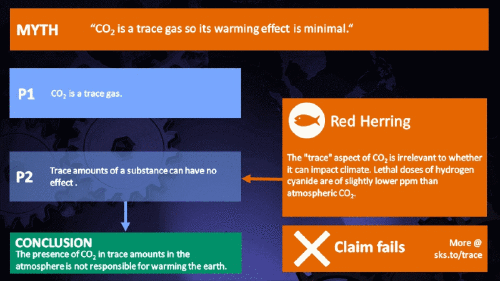

Deconstructing climate misinformation to identify reasoning errors
Cook, J., Ellerton, P., & Kinkead, D. (2018). Deconstructing climate misinformation to identify reasoning errors. Environmental Research Letters, 13(2), 024018. Link to PDF & Link to Supplement
The table below is inspired by the simplified supplement and may differ slightly from what is shown in the GIF. This is mostly due to make the text fit into the available space which made it necessary to reword some of it.
| 1 | Identify claim | CO2 is a trace gas so its warming effect is minimal. |
| 2 | Argument structure | Premise 1: Carbon dioxide is a trace gas. Conclusion: The presence of carbon dioxide in trace* amounts in the atmosphere is not responsible for warming the earth. |
| 3 | Inferential Intent |
Deduction |
| 4 | Validity | LOGICALLY INVALID Trace amounts of a substance can have an effect – the conclusion doesn't follow from the premise. |
| 4a | Hidden premises |
Premise 1: Carbon dioxide is a trace gas. |
| 5 | Check premises | Premise 1 is true. Premise 2 is false and a red herring. The "trace" aspect of CO2 is irrelevant to whether it can impact climate. Lethal doses of hydrogen cyanide are of slightly lower ppm than atmospheric CO2. |
| 6 | Status of claim |
FALSE |
| 7 | Summary of fallacies | Red Herring: The fact that CO2 is a trace gas is irrelevant to whether it can impact climate. Trace amounts of substances can have a strong effect – lethal doses of hydrogen cyanide are of lower dosage than atmospheric CO2. We know CO2 causes warming because satellites measure its warming effect — the increased greenhouse effect is an observed reality.. |
* Trace amounts in analytical chemistry are those less than 100 ppm. While C02 levels are higher than this, we can use the term more colloquially for the purposes of this exercise.
How substances in trace amounts can cause large effects
Blog post with background information about the myth deconstructions: Myth deconstructions as animated gifs
To learn more about the fallacies used in the myth deconstructions: A history of FLICC: the 5 techniques of science denial
 |
The Skeptical Science website by Skeptical Science is licensed under a Creative Commons Attribution 3.0 Unported License. |